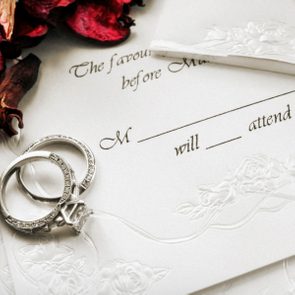It's pronounced missus, so why is there an r in Mrs.? It makes no sense ... until you learn the history.

Here’s Why There’s an “R” in “Mrs.”

You scribble it on envelopes, click it in dropdown menus, and hear it echo across classrooms and checkout counters. You see it on wedding invitations, gravestones and email signatures. It’s formal, tidy, traditional … and completely bizarre once you stop and actually look at it. It’s one of the most familiar words in the English language—and one of the strangest. It’s spelled with an r but pronounced without one. It sounds like a riddle, but I’m talking, of course, about the word Mrs.
Why is there an r in Mrs.? Why is it pronounced missus? And what does it actually stand for? To unravel the surprising story behind this tiny, tricky title, I consulted Laurel Brinton, PhD, professor emerita of English language at the University of British Columbia, Canada.
Read on for the mystery behind Mrs., which is a journey into history, language and tradition all rolled into one little word.
Get Reader’s Digest’s Read Up newsletter for more fun facts, grammar, humor, cleaning, travel and tech all week long.
How long has the honorific Mrs. been around?
Mrs. has been with us for a little over 500 years, but its origin goes back another 200 before that—to the 1300s. That origin we’re talking about? It’s the word mistress. These days, mistress usually refers to a romantic partner outside of marriage, but historically, it meant a woman with authority (akin to master for men).
“The word mistress, borrowed from French, was used first in the 14th century,” says Brinton. “Its first meaning referred to a governess, and it came to mean a female head of the family or one who had some sort of control over servants, and then a female teacher.”
By the 15th century, mistress was being used as a form of address, a title of courtesy. Beginning in the 16th century, Brinton says, mistress was abbreviated as Mrs. and a few other ways that didn’t stick around (Mist., Mistr., Mris.). Importantly, these were written abbreviations only.
Mistress was “one of a number of terms of respect that were used for women in the early modern English period,” Brinton adds. “They were very concerned during this period with rank, so a lady or dame was higher in rank than a mistress. But there were also more generic terms, like goodwife or gentlewoman.”
Why is there an r in Mrs.?

The answer to that question is simple: There’s an r in Mrs. because it’s a contraction of mistress, which has an r. As Brinton explains, Mrs. is an abbreviation, not a phonetic spelling. It was initially just a way to write mistress more quickly—long before the modern risqué connotation of the word took hold.
Why is Mrs. pronounced missus?
“Obviously, you can’t really pronounce Mrs. as it’s written,” Brinton says, “so they came up with something.” Since English speakers have a tendency to shorten spoken words, we soon dropped the tr in mistress, and the word came to be pronounced missus.
She explains that the Oxford English Dictionary (OED) cites a pronouncing dictionary from 1791 that says “mistress as a title is pronounced missus, and that ‘to be pronounced as written would [seem] quaint and pedantic.'” By the end of the 18th century, missus—once a colloquialism—came to be the only allowable pronunciation.”
In effect, Brinton notes, Mrs. and mistress diverged: Mrs. became the standard form of address, while mistress took on a separate meaning entirely.
Why is the r silent?
As noted above, Mrs. is an abbreviation, not a phonetic spelling. The r in Mrs. is a vestige of the word mistress, preserving the historical link to the term.
Mrs. isn’t the only word that’s pronounced differently than it looks like it should be. Take colonel (which sounds like a popcorn kernel) or the way we say Wensday (eliminating what appears to be an entire syllable in Wednesday).
When did Miss come into play?
Originally, Mrs. was applied to all women, regardless of marital status. This changed, according to Brinton, around 1667, when the word miss evolved to distinguish younger or unmarried women—especially those of higher social classes.
Miss was also the contraction of mistress, “just a cutting off of the end,” she adds. “Its first use was for a kept woman from 1606. From there, it came to be used as a polite term for an unmarried woman in 1667. Once miss was established as the term for a single gal, Mrs. was relegated to the married set.”
Take my favorite novel, Jane Austen’s Pride and Prejudice, published in 1813. Mrs. Bennett is the mother of the family; Miss Bennett (no first name needed) is the eldest unmarried daughter, Jane; and then per the etiquette of the times, the younger single daughters are known as Miss Elizabeth Bennett, Miss Mary Bennett, Miss Kitty Bennett and Miss Lydia Bennett.
When did Ms. come into play?
Ms. was first proposed as a title in 1901. An article in the Springfield Sunday Republican advocated for the creation of a way to address a lady without bringing up her “domestic situation.” According to the article, the word Ms. was simple and easy to write, and “the person concerned can translate it properly according to circumstance.” People were also already saying Mizz, an intentional slurring together of Miss and Mrs. for that very purpose.
But the honorific Ms. really gained widespread traction with the women’s movement of the 1960s and 1970s as a way to divorce a woman’s identity from her marital status—because whether or not she was married had no bearing on her standing. It then went on to become the title of the groundbreaking magazine founded in 1971 by Gloria Steinem and other leaders of the feminist movement. And the rest, as they say, is herstory.
Why is there only one honorific for men?
As for men, Mr. (from master) applies to a man regardless of his marital status. “We don’t distinguish between unmarried and married men,” says Brinton. “That’s just society.” For women, marriage used to signal a major identity shift—legally and socially. For men, it didn’t.
In terms of age, you’d probably reserve that honorific for a grown-up male, but Brinton says, “I can sort of hear it at a private boys’ school. They might address the boys as Master So-and-So.” (Dead Poets Society, anyone?)
Are any other honorifics making headway for women or men?
The gender-neutral honorific Mx. (pronounced mix) originated in 1977, according to the OED. More recently, it has been adopted as a title by those who don’t identify as male or female and are nonbinary, genderqueer, genderfluid or agender. It offers an inclusive alternative to Mr., Mrs., Miss and Ms. and is slowly being adopted in official settings, like forms, government paperwork and education.
So the next time you write Mrs., remember: It’s more than just a title. It’s a quirky little time capsule, packed with history, mystery and a silent letter that refuses to be forgotten.
About the expert
|
Why trust us
At Reader’s Digest, we’re committed to producing high-quality content by writers with expertise and experience in their field in consultation with relevant, qualified experts. We rely on reputable primary sources, including government and professional organizations and academic institutions as well as our writers’ personal experience where appropriate. We verify all facts and data, back them with credible sourcing and revisit them over time to ensure they remain accurate and up to date. For this piece on why there’s an r in Mrs., Jo Ann Liguori tapped her decades of experience as a copy editor to ensure that all information is accurate and offers the best possible advice to readers. Read more about our team, our contributors and our editorial policies.
Sources:
- Laurel Brinton, professor emerita at the University of British Columbia; phone interview, July 21, 2025
- Britannica: “Why is there an ‘R’ in Mrs.?”
- Emily Post Etiquette: “Ms, Miss, or Mrs: Guide to Addressing Women & Girls”
- Oxford English Dictionary
- New York Times Magazine: “On Language: Ms.”























